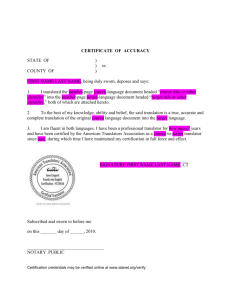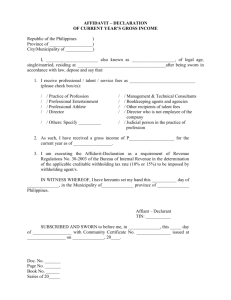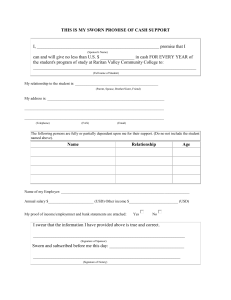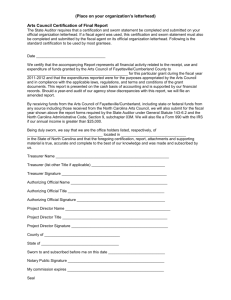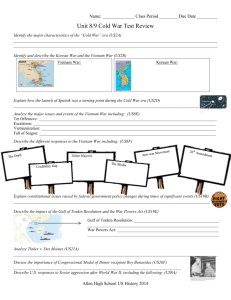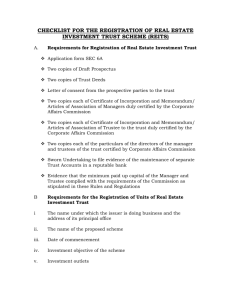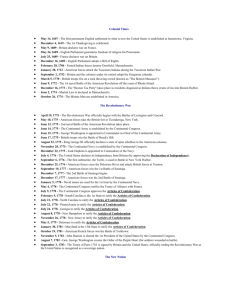American History - Louisiana History
advertisement
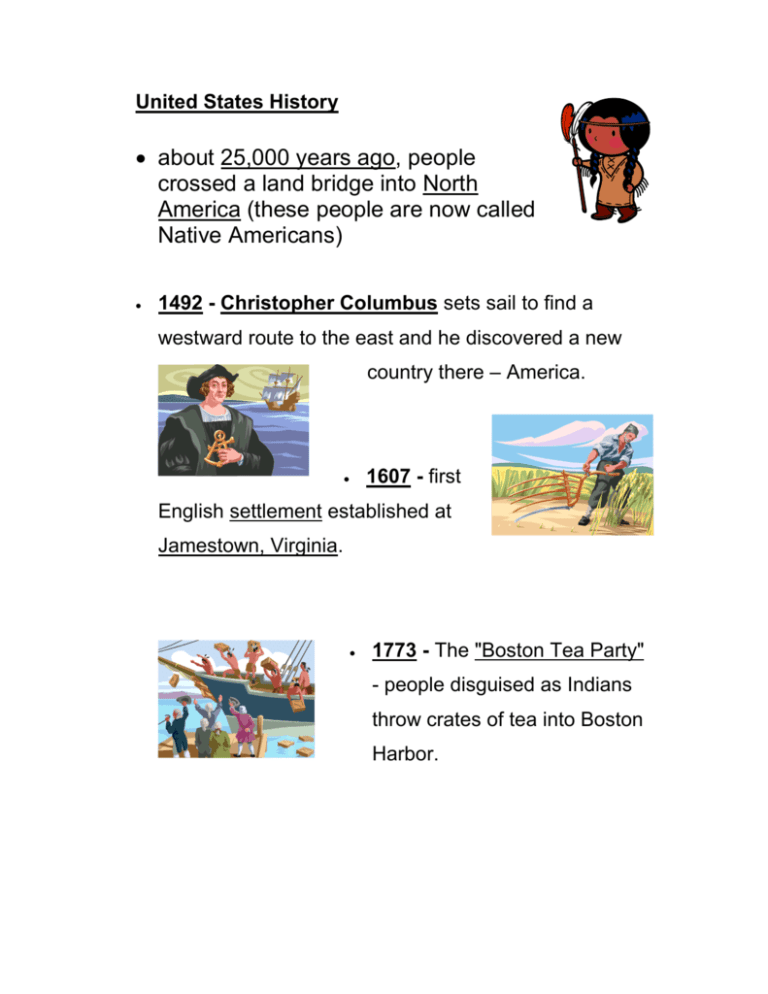
United States History about 25,000 years ago, people crossed a land bridge into North America (these people are now called Native Americans) 1492 - Christopher Columbus sets sail to find a westward route to the east and he discovered a new country there – America. 1607 - first English settlement established at Jamestown, Virginia. 1773 - The "Boston Tea Party" - people disguised as Indians throw crates of tea into Boston Harbor. The Revolutionary War 1775 - The Revolutionary War begins with Battles of Lexington and Concord. July 4, 1776 - The United States declares its Independence from Britain (by approving the Declaration of Independence). The New Nation September 17, 1787 - The delegates at the Philadelphia convention approve the Constitution. 1789 - George Washington is sworn in as the first President of the United States. 1791 - Bill of Rights is ratified by 3/4ths of the states and becomes part of the U.S. Constitution. 1796 - Tennessee is the 16th state admitted to the Union. Tennessee became a state on June 1, 1796. On June 8, 1861, it joined the Confederacy and became a major battleground for the Civil War, re-entering the Union after war's end. Area - 42,145 sq. miles Capital - Nashville 1803 - United States purchases the Louisiana Territory for $15 million, containing what is now Arkansas, part of Colorado, Iowa, Louisiana, part of Minnesota, Missouri, part of Montana, part of North Dakota, part of Oklahoma, South Dakota, and part of Wyoming. War of 1812 1812 - United States declares war on Britain. December 24, 1814 - The United States and Britain sign the Treaty of Ghent, ending the War of 1812. 1849 - Harriet Tubman escapes from slavery on the "Underground Railroad". Secession November 6, 1860 – Abraham Lincoln is elected President. (right) December 20, 1860 - South Carolina is the 1st state to secede from the Union. February 4, 1861 - The Confederate States of America is formed. February 18, 1861 - Jefferson Davis becomes the 1st President of the Confederate States of America. 1861 - Confederate forces begin an assault on Fort Sumter. The Civil War North – Union – President Abraham Lincoln – main general: Ulysses S. Grant South - Confederacy – President Jefferson Davis – main general: Robert E. Lee January 1, 1863 - The Emancipation Proclamation is issued. July 3, 1863 - Union forces win the Battle of Gettysburg. November 19, 1863 – Abraham Lincoln gives the Gettysburg Address. 1865 - The 13th Amendment is passed by Congress. (no more slavery) April 9, 1865 - The Confederate States of America surrender at Appomattox Courthouse, ending the Civil War Union Flag (north) What???? Confederate Flag (south) April 14, 1865 – Lincoln was shot by a man who thought he was helping the South (John Wilkes Booth). Reconstruction July 24, 1866 - Tennessee is the 1st state to be readmitted to the Union. 1867 - The United States purchases the Alaska Territory from Russia for $7.2 million. May 10, 1869 - The Transcontinental Railroad is completed at Promontory Point, Utah. The Spanish-American War April 20, 1898 - The United States declares war on Spain. August 12, 1898 - The United States and Spain sign an armistice, ending the Spanish-American War. (above: charge of the Rough Riders, led by Teddy Roosevelt) The American Empire September 14, 1901 - Theodore “Teddy” Roosevelt is sworn in as the 26th President of the United States. June 28, 1914 – someone from Serbia assassinated Archduke Ferdinand of Austria-Hungary. World War I July 28, 1914 - World War I began when Austria declared war on Serbia. 1914 - The Panama Canal opened. May 7, 1915 - British ship Lusitania was sunk by German U-Boats, killing 128 American passengers. 1917 - The United States entered World War I on the side of the Allies. November 11, 1918the Germans gave up, and the war was over (the Allies won). World War I (1914-1918): o Allies: Britain, France, Russia, Italy (1915), United States (1917) o Central Powers: Austria-Hungary, Bulgaria, Germany, Ottoman Empire o weapons: trenches, barbed wire, land mines, machine guns, early tanks, poison gas, U-boats The Roaring 20's 1920 - The 19th Amendment (all people can vote including women) was added to the Constitution. 1920 – 1929 - Most people had money, and people were happy. The Great Depression October 29, 1929 - The New York stock market crashed and the Great Depression began. Herbert Hoover was President, and people blamed him for how bad life was. People lived in tents together, and they called them “Hoovertowns.” 1933 - Franklin Delano Roosevelt (FDR) became the 32nd President of the United States. He helped us get out of the Depression. World War II September 1, 1939 - Germany invaded Poland. (beginning of World War II) December 7, 1941 - Japan attacked the United States at Pearl Harbor, Hawaii. December 8, 1941 The United States declared war on Japan. December 11, 1941 Germany and Italy declared war on the United States. June 6, 1944 - Allied forces invaded Normandy (referred to as "D-Day"). 1945 - Harry Truman was sworn in as the 33rd President of the United States. August 6, 1945 - The United States dropped the 1st atomic bomb on Hiroshima, Japan (Harry Truman was President). August 9, 1945 - The United States dropped the 2nd atomic bomb on Nagasaki, Japan. September 2, 1945 - Japan surrendered to the United States, ending World War II. (the Allies won) World War II (1939-1945): o Allies: United Kingdom, France, USSR, United States (1941), and a bunch of other countries o Axis: Germany, Japan, Italy o weapons: machine guns, sniper rifles, grenades, flame throwers, bazookas, tanks, submarines, ships, airplanes, atomic bomb after WWII, Korea was divided into North Korea and South Korea, Vietnam was divided into North Vietnam and South Vietnam, and Germany was divided into East Germany and West Germany (they made a wall between them called the “Berlin Wall.”) The Cold War (1946-1992) October 17, 1946 - Winston Churchill proclaims "an iron curtain has swept across the continent (Europe)," beginning the Cold War. This was not an actual war, but a feeling of being close to war between the United States and the Soviet Union. Both countries built many nuclear missiles during this time. 1989 – The Berlin Wall (which divided East Germany and West Germany) came down, symbolizing the end of the Cold War. The Korean War June 25, 1950 The Korean War officially starts as North Korea invades South Korea. (North Korea: communist South Korea: noncommunist) January 20, 1953 - Dwight Eisenhower is sworn in as the 34th President of the United States. July 27, 1953 – Korean War ends when a ceasefire is signed. Sherman Tanks (above right) were used in the Korean War. Douglas MacArthur (below) was the main general for the Allies in this war. January 21, 1957 - Dwight Eisenhower is sworn in as President for a 2nd term. January 3, 1959 - Alaska is the 49th state admitted to the Union. Alaska became the 49th state on January 3, 1959; it was the first new state in the Union since 1912. August 21, 1959 - Hawaii is the 50th state admitted to the Union. January 20, 1961 - John F. Kennedy (JFK) is sworn in as the 35th President of the United States. January 20, 1961 - Lyndon Johnson is sworn in as the 37th Vice President of the United States. B-29 Bombers were used in the Korean War (right). Civil Rights May 17, 1954 - The Supreme Court rules on the landmark case Brown v. Board of Education of Topeka, Kans., unanimously agreeing that segregation in public schools is unconstitutional. 1955 - Rosa Parks refuses to give up her seat at the front of the "colored section" of a bus to a white passenger, defying a southern custom of the time. In response to her arrest the Montgomery black community launches a bus boycott, which will last for more than a year, until the buses are desegregated Dec. 21, 1956. 1957 - Nine black students are blocked from entering the all-white Central High School school on the orders of the Governor. President Eisenhower sends federal troops and the National Guard to intervene on behalf of the students, who become known as the "Little Rock Nine." 1962 - James Meredith becomes the first black student to enroll at the University of Mississippi. Violence and riots surrounding the incident cause President Kennedy to send 5,000 federal troops. August 28, 1963 About 200,000 people join the March on Washington. Congregating at the Lincoln Memorial, participants listen as Martin Luther King delivers his famous "I Have a Dream" speech. July 2, 1964 - President Johnson signs the Civil Rights Act of 1964. The most sweeping civil rights legislation since Reconstruction, the Civil Rights Act prohibits discrimination of all kinds based on race, color, religion, or national origin. August 10, 1965 - Congress passes the Voting Rights Act of 1965, making it easier for Southern blacks to register to vote. Literacy tests, poll taxes, and other such requirements that were used to restrict black voting are made illegal. April 4, 1968 - Martin Luther King, at age 39, is shot as he stands on the balcony outside his hotel room. Escaped convict and committed racist James Earl Ray is convicted of the crime. The Cuban Missile Crisis April 17, 1961 - An American backed Cuban invasion force landed at Bahia de Cochinos (Bay of Pigs). October 14, 1962 - American spy planes spot Soviet missile bases on Cuba. October 22, 1962 - The Soviet Union pulls its missiles out of Cuba. November 22, 1963 – JFK (John F. Kennedy) was assassinated by Lee Harvey Oswald in Dallas Texas in a motorcade. (JFK on right) The Vietnam War November 22, 1963 Lyndon Johnson is sworn in as the 36th President of the United States. August 4, 1964 - Vietnamese forces attack an American Destroyer (USS Maddox), and the Vietnam War begins. (North Vietnam: communist South Vietnam: noncommunist) August 7, 1964 - The United States begins military presence in Vietnam. January 20, 1965 - Lyndon Johnson is sworn in as President for a 2nd term. January 20, 1969 - Richard Nixon is sworn in as the 37th President of the United States. July 20, 1969 - American astronaut Neil Armstrong is the 1st human to walk on the Moon. (right) January 20, 1973 - Richard Nixon is sworn in as President for a 2nd term. January 27, 1973 - The United States and Vietnam sign a peace treaty, and the Vietnam War ends. Iran Hostage Crisis August 9, 1974 - Gerald Ford is sworn in as the 38th President of the United States. January 20, 1977 - Jimmy Carter is sworn in as the 39th President of the United States. November 4, 1979 - Iranians seize the American Embassy in Tehran, Iran, taking 52 people hostage. January 20, 1981 - Ronald Reagan is sworn in as the 40th President of the United States. January 20, 1981 - George Bush is sworn in as the 43rd Vice President of the United States. January 20, 1981 - The hostages from the American Embassy are freed. (left) January 21, 1985 - Ronald Reagan is sworn in as President for a 2nd term. January 20, 1989 - George Bush is sworn in as the 41st President of the United States. The Persian Gulf War August 2, 1990 - Iraqi forces invade Kuwait. Saddam Hussein was the leader of Iraq. February 28, 1991 - A cease fire is signed between the United Nations and Iraq. February 1, 1992 - The United States and Russia sign a treaty. The Cold War ends. The Information Age 1992 - Bill Clinton is elected as the 42nd President of the United States. 1993 - A truck Bomb exploded in the parking garage under the World Trade Center in New York City, killing six people and injuring thousands. 1996 - Bill Clinton is reelected as President of the United States. 2000 - Texas Governor George W. Bush (George Bush’s son) won by 537 votes in Florida in a highly contested election against the incumbent Vice President Al Gore. September 11, 2001 – Nineteen terrorists hijacked four planes and crashed them into the World Trade Center, The Pentagon, and a field in Pennsylvania killing nearly three thousand people and injuring over six thousand. Osama bin Laden said he was responsible for the attacks. (2001–present): The United States launched an invasion of Afghanistan. 2003 - The United States, United Kingdom, Australia and Poland invaded Iraq. 2003 - Iraqi President Saddam Hussein was captured by United States special forces. 2004 – George W. Bush is reelected as President of the United States. 2008 – Barack Obama is elected as President of the United States. He is the first African-American President. 2011 – Osama bin Laden was shot by United States special forces. 2012 – After a highly contested Republican race, Mitt Romney will most likely face Barack Obama for the Presidential election of 2012.
